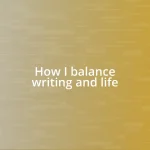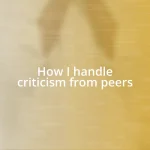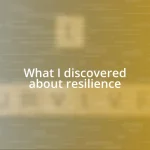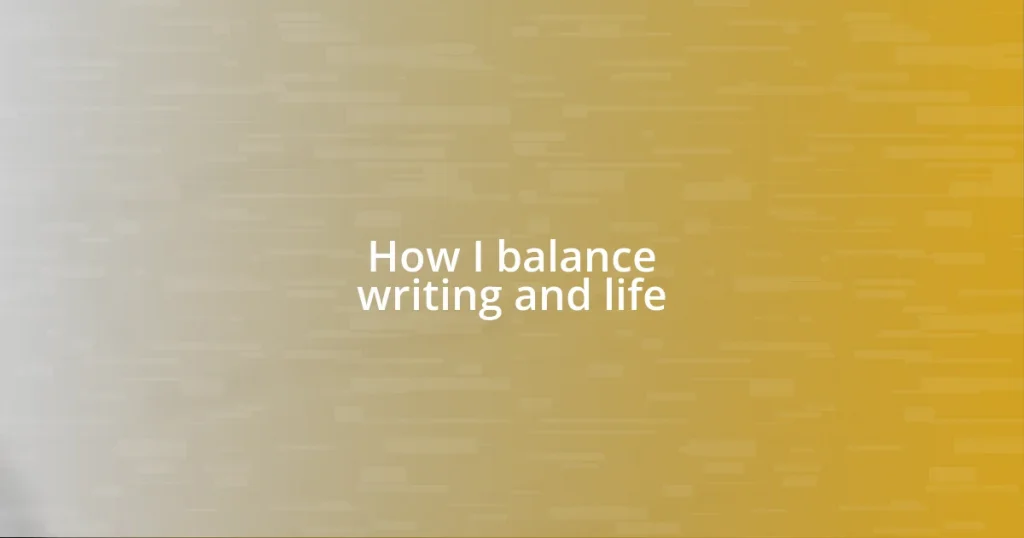Key takeaways:
- Understanding risk involves balancing emotions, learning from experiences, and transforming uncertainty into opportunities for growth.
- Identifying personal motivations, whether intrinsic or extrinsic, helps clarify goals and influences decisions, aiding in the navigation of internal conflicts.
- Reflecting on outcomes fosters resilience and self-awareness, highlighting the importance of community support and constructive feedback in personal development.

Understanding the concept of risk
Risk, at its core, is about the uncertainty of outcomes. I remember vividly when I took a leap into entrepreneurship. With every decision, I faced the possibility of failure, yet the thought of what could be achieved kept me going. How often do we weigh the potential benefits against the fear of loss in our own lives?
Understanding risk often means grappling with our emotions. Fear can be paralyzing; I’ve felt it when considering major life changes, like moving to a new city. But what I’ve learned is that risk can also ignite excitement and growth. Isn’t it fascinating how our mindset can transform uncertainty into an opportunity for personal development?
Every risk comes with its own set of variables. I’ve encountered situations where the odds were stacked against me, yet I took a chance anyway, believing in the possibilities. This blend of apprehension and hope, I’ve found, is what makes taking risks such a profoundly human experience. How do you navigate the balance between caution and courage in your own decisions?

Identifying personal motivations
Identifying personal motivations is a journey that often reveals our deepest desires and fears. I remember a time when I pondered why I wanted to shift my career path entirely. The realization struck me: my motivations were rooted in a longing for fulfillment rather than mere financial stability. Exploring these motivations helped clarify my goals; once identified, it became easier to prioritize my decisions.
I’ve noticed that sometimes my motivations can contradict each other. For instance, I often feel drawn to secure, stable jobs while simultaneously yearning for creative freedom. This internal conflict is a common experience, and I’ve learned to embrace it. By acknowledging these different facets, I can understand what drives me more fully—it’s about finding a balance between security and passion that fuels my pursuits.
Engaging in self-reflection has enhanced my understanding of what truly propels me forward. For example, during a particularly challenging project, I discovered that my motivation wasn’t just about the end goals but the satisfaction of learning throughout the process. Recognizing this allowed me to take risks without the overwhelming fear of failure clouding my judgment. What motivates you, and how do those motivations influence your decisions?
| Motivation Type | Examples |
|---|---|
| Intrinsic | Creative fulfillment, personal growth, learning |
| Extrinsic | Financial rewards, recognition, job security |

Evaluating potential consequences
Evaluating potential consequences is a crucial step in the risk-taking process. I often reflect on my experiences, especially when I decided to invest in a startup. The fear of losing my savings was palpable, yet I knew that weighing the consequences—both positive and negative—was essential. This evaluation helped me feel more grounded and prepared for whatever outcome lay ahead.
Here are some potential consequences I consider when evaluating risks:
- Financial Impact: Could I afford to lose this investment?
- Emotional Strain: How would I feel if things didn’t go as planned?
- Reputation Risk: Could this decision affect my professional relationships?
- Opportunity Cost: What am I giving up to pursue this risk?
- Learning Experience: Will this risk help me grow, regardless of the outcome?
As I contemplated these factors during my decision-making process, I felt a mix of excitement and anxiety. Each consequence was a thread in the fabric of my potential future, guiding me towards the decision that felt right at that moment. Balancing these evaluations allows me to embrace risks with a clearer mind and an open heart.
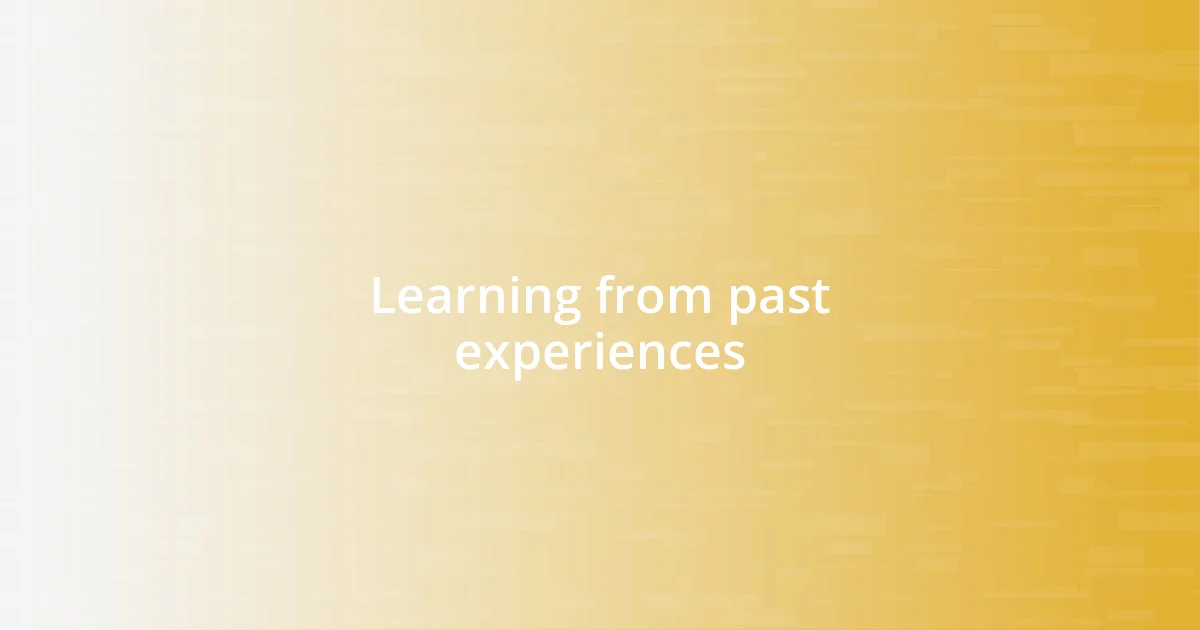
Learning from past experiences
Reflecting on my past experiences has been a powerful teacher. I recall a moment when I hesitated to speak up during a team meeting, worried my ideas might be dismissed. Afterward, I felt a mix of regret and relief. That experience taught me the importance of advocating for myself; every time I take that leap now, I remind myself that my voice matters. Have you ever felt that urge to hold back? Learning to navigate these moments of doubt has reshaped my approach to risk.
Memories often hold invaluable lessons, especially when it comes to facing challenges. During one chaotic project, I took a leap of faith by proposing an unconventional strategy. Initially, it felt terrifying. I still vividly remember the raised eyebrows and whispered doubts around the table. But once it gained traction, it not only delivered success but also taught me about resilience in the face of skepticism. Each experience like that reinforces my belief: sometimes, the biggest risks lead to the greatest rewards.
As I navigate new risks, I’ve started to journal about my experiences. Writing about past decisions helps me see patterns in my choices, revealing where I’ve either thrived or stumbled. Just the other day, I was reflecting on a particularly bold move I made a few years ago. Looking back, I realized how much I’ve grown since then, and it made me wonder—what if I hadn’t taken that leap at all? Each entry serves as a reminder that my journey is a continuous learning process. What have you learned from your own past experiences?

Developing a risk-taking mindset
To foster a risk-taking mindset, I’ve found that embracing uncertainty is key. I remember the first time I decided to travel solo; my heart raced at the thought of navigating foreign landscapes alone. The unfamiliarity felt daunting at first, but as I pushed through the discomfort, I discovered a confidence I didn’t know I possessed. Have you ever ventured out of your comfort zone and found strength within yourself that surprised you?
Balancing optimism with caution is another vital aspect of developing this mindset. I often start each day by visualizing possible outcomes, both good and bad. For instance, when I chose to pivot my career path, I envisioned the potential joys of success along with the shadows of failure. This duality helped me stay grounded and prepared, transforming fear into a motivating force. Embracing this balance encourages me to take calculated risks that feel both exciting and manageable.
Moreover, sharing my thoughts with others has been instrumental in this journey. I’ve joined forums where people discuss their risk-taking stories and listen actively to their insights. Their triumphs and failures resonate with me, reminding me that risk is universal. Every voice adds another layer to my understanding, reinforcing that while the path to success is seldom linear, it becomes more navigable through shared experiences. Isn’t it interesting how community can bolster our courage to leap into the unknown?

Crafting a strategic plan
Crafting a strategic plan starts with a clear vision of what you want to achieve. I remember when I first attempted to outline a long-term project. It felt overwhelming at first, like staring at a blank canvas. I decided to break it down into manageable chunks, detailing each step I wanted to take. This not only made the task less daunting but also allowed me to visualize my goals more clearly. Have you ever found clarity by simply breaking things into smaller parts?
Once I had my vision, I focused on understanding my resources—what I already had and what I needed. It was during this phase that I realized my network was invaluable. I reached out to mentors and friends for guidance, and their insights opened my eyes to possibilities I hadn’t considered. Building a strategic plan isn’t just about what you can do alone; it’s about leveraging the support and knowledge of others. How has collaboration influenced your plans in the past?
Lastly, I learned that flexibility is an essential component of any strategic plan. I recall presenting my initial ideas to my team, only to face several unexpected objections. Instead of clinging to my original plan, I encouraged open dialogue. This willingness to adapt led to refining our approach, which ultimately resulted in a more innovative solution. It taught me that the best plans are living documents, continually evolving as we gain new insights. Can you think of a time when being adaptable led you to a better outcome?

Reflecting on the outcomes
Reflecting on the outcomes often reveals deeper lessons than the experience itself. When I ventured into public speaking for the first time, I vividly remember standing in front of an audience, my palms sweaty and voice shaky. The moment I finished my speech felt both exhilarating and terrifying. I could see the mixed expressions of my listeners—some intrigued, some puzzled. It wasn’t just about the applause; it was about learning to embrace vulnerability and imperfection. Have you ever stood in front of a crowd and discovered more about yourself than you anticipated?
Looking back, I also notice that the reactions of others offered significant insights. After that nerve-wracking speech, a few audience members approached me with encouragement and constructive feedback. They didn’t just see the performance; they saw the effort and courage behind it. Each interaction opened my eyes to the importance of community support in assessing outcomes. Isn’t it fascinating how others can reflect back the growth we might overlook in ourselves?
Ultimately, what stands out the most is the inner transformation influenced by taking that risk. I began to appreciate the value of constructive self-critique—acknowledging areas for improvement without beating myself up. Every small success and setback became a building block in my confidence journey. How often do you take a moment to acknowledge your growth, no matter how small? I’ve found that this reflection not only shapes future risks but instills a sense of resilience that’s invaluable.
